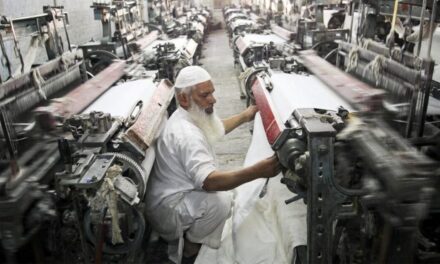 One year after the global trade wars ignited, thousands of representatives from the Canadian apparel and textile industry – from designers and brands, to retailers, e-commerce sellers, importers and buying offices – were out in full force at the fourth annual Apparel Textile Sourcing Canada (ATSC) show in Toronto in search of trade policy updates, future market directions, and new opportunities for international trade and sustainable global sourcing.
One year after the global trade wars ignited, thousands of representatives from the Canadian apparel and textile industry – from designers and brands, to retailers, e-commerce sellers, importers and buying offices – were out in full force at the fourth annual Apparel Textile Sourcing Canada (ATSC) show in Toronto in search of trade policy updates, future market directions, and new opportunities for international trade and sustainable global sourcing.
The show – which took place August 19-21 – did not disappoint, delivering more than 300 international supplier exhibits, representatives from 25 countries and Canada’s most comprehensive industry conference, featuring a leading roster of business and industry heavy hitters who shared their insights, market intelligence and fashion business-building inspiration.
“The bustle of activity over the three days of the show is testament to both the growing Canadian apparel and textile sector, and the need for a global fair such as ATSC to enable industry players to make international business connections, network and get educated on navigating the new realities of the world’s sourcing ecosystem without having to leave their home turf,” said Jason Prescott, CEO of JP Communications, producer of the show and publisher of North America’s leading of B2B trade platforms TopTenWholesale.com and Manufacturer.com.
China and emerging markets
 In spite of Canada’s wavering international trade scenario, the message to local businesses and designers was clear: while new opportunities for alternative sources of supply are emerging and growing – including with countries such as Bangladesh, India, Turkey, Latin America and Africa – trade with China is still thriving and key for the health and growth of Canadian businesses.
In spite of Canada’s wavering international trade scenario, the message to local businesses and designers was clear: while new opportunities for alternative sources of supply are emerging and growing – including with countries such as Bangladesh, India, Turkey, Latin America and Africa – trade with China is still thriving and key for the health and growth of Canadian businesses.
Han Tao, Consulate-General of the People’s Republic of China in Toronto, told the crowd of attendees that both Chinese apparel imports and exports were up last year in Canada. He reported that imports were up 3.7 percent year-over-year in 2018 to $6.4 bn, while exports increased 110 percent year-over-year to $53 mn, largely due to Chinese shipments of Canadian outerwear and active brands such as Canada Goose and Lululemon.
Industry leaders Bob Kirke, Executive Director of the Canadian Apparel Federation, Julie Hughes, President of the DC-based United States Fashion Industry Association (USFIA) and Jeff Streader, Managing Director of Go Global Retail, echoed the message of myriad opportunities for alternative sources of supply for local businesses, brands, retailers and designers navigating the unfolding trade reality, while emphasizing China’s continued importance as an industry supplier. “China is still the team to beat,” Streader said.
Other key show speakers – whose topics ranged from working with alternative sourcing channels and overseas factories, to sustainable sourcing and business practices, to launching and building a successful brand, included:
- Mahesh Sanil, Executive Director of the Wool and Woollens Export Promotion Council (WWEPC)
- Sam Dentu, Director of the Ghana Export Promotion Authority
- Antonio Ramos, Trade Advisor of Peru in Toronto
- Avedis Seferian, President and CEO of Worldwide Responsible Accredited Production (WRAP)
- Sal Khokhar, CEO of Kollective Moda
- Analucia Beltran, Brand Ambassador for Korite Jewelry
- Katherine Stein, Director of Business Development at SGS
- Gabriella Smith, Founder of the UpCycle Project
- Roger Lamoureux, Director, Fashion Merchandising of Today’s Shopping Choice
- Pamela Bokser, Director Softgoods Direct Imports of Giant Tiger
- Steve Tipman, Executive Director of TFO Canada
- And many others.
Fashion Lab draws crowds
The Fashion Lab conference series – introduced to the show for the first time – drew overflowing crowds of small businesses and up-and-coming designers looking to build their brands. Industry experts and top fashion influencers offered advice on topics such as how to successfully launch a fashion line, tips and tricks to drive website traffic and boost online sales, emerging technologies that change the way consumers interact with brands, strategies and tactics for e-commerce, new digital shopping channels, experiential retail, sustainable solutions, the critical role of social media in the world of fashion, how to successfully working with a manufacturer and best advice to cost merchandise for maximum sales success.
Another show first was the introduction of a Footwear Pavilion to the show’s global offering, giving Canadian retailers and brands direct access to international factories for footwear production sourcing. A show-stopping fashion show on day two – organized in partnership with Toronto modeling agency Spot 6 Management – showcased the latest creations by local designers Farley Chatto, Rhowan James, Dorian Who, Christopher Paunil and JmTrends, as well as some of Toronto’s best up-and-coming talent. Trending designs from around the globe also took to the runway, courtesy of ATSC exhibitors from India and Bangladesh, and the latest fashions from eight of China’s top brands, sponsored by the Ministry of Commerce of China, featured in the show’s Brand China AVENUE section: Veralba, Sanyi, Rebody, Jilier, HODO, Bosideng, Aparso and Aiyimei.
At the opening of the show, these Chinese brands also donated $20,000 worth of goods from the show floor to Brands for Canada, a Toronto-based non-profit organization that distributes new donated clothing, personal care and other basic essential products directly to families across Canada at no cost.
Following the Toronto show, ATSC exhibitors traveled to Montreal for the event’s second edition in the city. ATSC Montreal drew record attendance this year, delivering a key boost to the local apparel and fashion manufacturing scene as it undergoes a major revival.





















